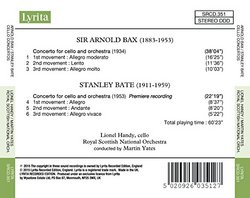| All Artists: Lionel Handy Title: Stanley Bate & Sir Arnold Bax: Cello Concertos Members Wishing: 0 Total Copies: 0 Label: Naxos of America, Inc. Release Date: 3/11/2016 Genre: Classical Styles: Forms & Genres, Concertos Number of Discs: 1 SwapaCD Credits: 1 |
Search - Lionel Handy :: Stanley Bate & Sir Arnold Bax: Cello Concertos
 | Lionel Handy Stanley Bate & Sir Arnold Bax: Cello Concertos Genre: Classical The first of his pieces for solo instrument and orchestra which Bax officially designated a concerto was the Cello Concerto of 1932. In the Cello Concerto, the instrument is centre stage virtually from beginning to end and... more » |
Larger Image |
CD Details
Synopsis
Product Description
The first of his pieces for solo instrument and orchestra which Bax officially designated a concerto was the Cello Concerto of 1932. In the Cello Concerto, the instrument is centre stage virtually from beginning to end and the composer takes great pains to ensure that it is clearly audible at all times. To accomplish this, he uses modest forces: three flutes, two oboes, cor anglais, two clarinets, two bassoons, contrabassoon, four horns, two trumpets, timpani, harp, celesta and strings. By the composers usual standards, this orchestration is notably restrained, with an absence of trombones and tuba and only two trumpets, the second of which does not feature at all in the first movement. When supporting the soloist, textures often take on the transparency of chamber music and are varied with such invention and flair (including much creative use of divided strings) that we rarely encounter the same combination of instruments accompanying the cellist for two phrases in succession. Before he wrote his Cello Concerto in 1953, Bate had produced a couple of instrumental works for cello and piano, consisting of a Recitative, op.52a (1945), and a Fantasy, op.56 (1947). The fluency of his writing in the concerto suggests that the composer had a natural empathy with the solo instruments lyrical and declamatory nature. It was premiered in late 1954 by the Eastman Rochester Orchestra at the Eastman School of Music, New York. Compact and sparingly scored, Bates concerto maintains the spotlight firmly on the soloist throughout. A sizeable orchestra is rarely exerted at full stretch and then only fleetingly. It is made up of two flutes, two oboes, clarinet, two bassoons, four horns, three trumpets, three trombones, tuba, timpani, cymbals and strings.
